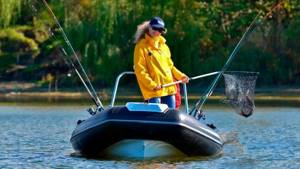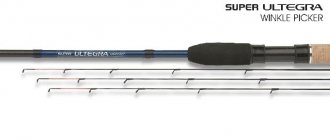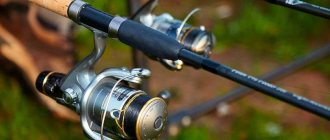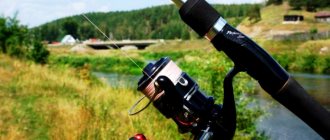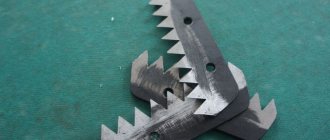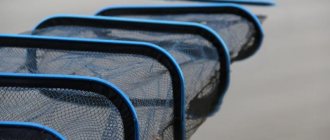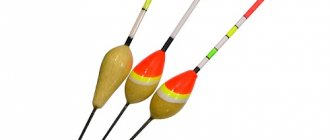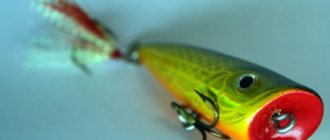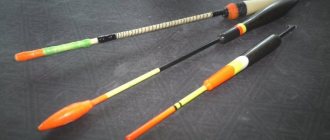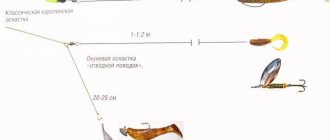Why do you need a picker when you have a float and a feeder?
Despite the ingenious simplicity and success of the float fishing rod, it is not always and everywhere capable of demonstrating all its best qualities. Often the entire pond along the shoreline is densely overgrown with aquatic vegetation. And this strip of hornwort and mud, and on the lakes - of water lilies or water lilies - simply does not allow you to cast a fishing rod. In such situations, it is impossible to reach clean water with a float rod with blind equipment. In another case, casting a float rod can only occur in shallow coastal waters, where in the summer mostly small fish are found. The slope to the hole and the fish “path” are somewhere further away, where you can’t reach with a fly fishing rod... Then you can use long casting using match, Bolognese or plug tackle. But there are days when it is impossible to catch with float tackle at all due to strong wind and waves. And here a picker will help, which is a type of English donkey, like a feeder, only in a more elegant and miniature version, which does not involve ultra-long casting of heavy feeders. Just right for slow-water fishing for crucian carp, carp, rudd, roach, silver bream and bream.
Similarities between pickerel and float rods
Simplicity and lightness are to some extent similar to a pickerel and a float fishing rod, since both of these tackles are designed for catching active fish with frequent casts and quick catching of prey. There is another similarity between a pickerel and a fly float rod: fishing is often done in weight, without supports. But, despite the lightness and subtlety of the equipment, large fish are also caught with a pickerel, sometimes even trophy ones. This is facilitated by the presence of a spinning reel and the general flexibility of the gear.
Weights and feeders for pickerel fishing
When fishing with pickerel, fairly light weights and feeders are used. This is due to frequent casting, small testing of the rod, and the possibility of feeding from a slingshot. The use of heavy, large-volume feeders is excluded.
Feeders in currents and standing water must be used open in front and behind, preferably cylindrical in shape. You can use “chebaryukovka”, but of the appropriate weight. In ponds they fish with flat and banjo - the picker test allows you to throw a not very heavy flat feeder and a banjo that does not fall deep into the grass and silt.
In terms of weights, we can recommend a spoon on a rocky bottom, an olive and a ball on hard soils, and a flat one on muddy bottoms, since it sinks less in the silt. The main advantage of a weight over a feeder is that at shallow depths when casting, it scares away the fish less than a feeder, and the bait is delivered to the bottom faster. The second advantage is that it flies more accurately. Third, the load is inexpensive, and it’s not too bad to tear it off when caught.
fishing weights in the Rybolov.ORG store
On a medium-flow river, a ball weight weighing 25 grams is enough for all fishing conditions, and only on rocks is it better to take a small spoon, which “takes off” and goes over the stones easier than a carp spoon, but flies and holds the bottom much worse.
Any weight must have a steel eye of small diameter so that it can be used to perform inline installation, otherwise it is only suitable for blind installation with a sinker, which is also used when fishing with a picker, but less often than inline.
Thimble feeders are often used. The author of the article believes that this is a purely sporting feature and the average fisherman does not need them. It is quite enough to use a small feeder with a main load of 30 grams, a length of 4-6 cm and a diameter of up to 4. The food from the thimble will be washed out worse, and its quantity is not enough to influence the fish’s interest in the fishing spot under normal conditions.
What weights and feeders should not be used when fishing with pickerel? Firstly, all kinds of missiles. They are used for long-range fishing, and a picker is rarely thrown beyond 50 meters. And they hold the bottom disgustingly. Secondly, the loads and feeders are too heavy. Typically, their weight should be no more than 80% of the maximum test of the rod, that is, 30-50 grams. There is also no need to use feeders of too large a volume - when you need to feed a point quickly and in a large volume, it is easier to use a slingshot with a picker.
What is a picker?
“Trembling” tip – quivertip
As already mentioned, a picker can also be fished in strong winds, which is completely unsuitable for a float rod. It is clear that the wind also affects the thin tip of the picker, which plays out the strongest gusts, but the bite is still clearly noticeable. The picker rod is equipped with bite alarms based on the “quivertip” principle, that is, interchangeable tips of varying strength and flexibility. To catch crucian carp, known for its delicate bite, you should choose the softest tips. They are similar in their qualities to the nod of a winter fishing rod. But so that the bite does not go unnoticed, the tip must be in a tensely bent form. And to do this, immediately after casting, you need to reel in the line and take out the slack. Then any touch of soft crucian carp lips will be marked by the so-called “trembling” tip - quivertip. These can be small jerks and twitches, and sometimes the tip, on the contrary, moves back to its original position. There is an analogy here with a crucian carp biting on a fly rod when the float rests on the water.
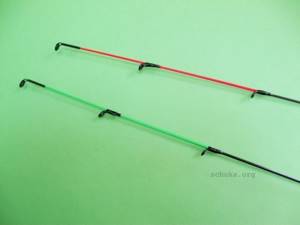
Picker rods
When equipping a fishing rod according to the “quivertip” principle, it must be taken into account that picker rods are not designed for casting massive feeder feeders. Since this is a light and sensitive tackle, small weights are often used for pickerel fishing. With this method of loading gear, the bait is simply thrown in by hand if the chosen fishing spot is close to the shore. To feed more distant fish paths, a special slingshot is used.
The most common length of picker rods is 2.7 meters and they are usually double legged. They can be called relatively short when compared with rods for feeder or fly fishing, but active fishing requires just such rods. In addition, picker fishing is aimed at coastal areas of water bodies, where there is no need for ultra-long casts. The range of test indicators is in the range of 10-30 grams. The weight of the weight or feeder must exactly match the test, otherwise, in addition to the risk of breaking the rod or tip, the angler will receive incorrectly adjusted gear.
When installing the tackle and reeling in the fishing line, a rough tip will inevitably move the feeder or weight at the bottom if their weight is lighter than the test weight. A flimsy quivertip can suffer when casting an excessively heavy load. When using feeders, you should also take into account the weight of the bait, since a filled feeder can be almost twice as heavy as the test indicator.
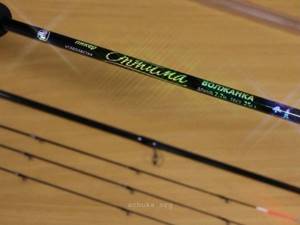
Bait for pickerel
There is an opinion that the use of feeders for pickerel fishing is the exception rather than the rule, and this imposes special features on picker bait. The bait is made thicker than the feeder bait mixture, and you need to make sure that the bait ball does not break when it hits the water.
In order for a strong current to wash out less food when sinking to the bottom, you need to speed up the immersion of the balls. And to do this, it is necessary to make the bait heavier by adding clay to it, weighing 30% -50% of the volume of the bait. We do not recommend using earth or sand, as they do not have the same viscosity as clay.
Let's summarize all the above information. So, a picker, unlike a feeder, has a shorter length, weight and test, which makes it a very delicate tackle, and allows you to fish with it only at a short distance from the shore, unlike a powerful feeder.
Read many useful articles about feeder fishing in our section here.
Picker equipment
Weight or feeder
Although in pickerel fishing a weight is more often used, in some cases light spiral feeders weighing about 15-20 grams come in very handy.
Their use is appropriate in places with little current. Therefore, you should always have a set of such feeders in stock. Just like in the feeder, cage feeders are also used for picker fishing, but usually the lightest of them, corresponding to the action of the rod. Of course, at long distances they will be inferior to modern feeders such as Method and in particular Flat, which are more often used in feeder fishing, but an angler with a picker does not need ultra-long throws.

What coils do you use?
For picker fishing, both spinning spinning reels and match reels are used. Match reels are considered more successful in use because they lay well and reel in the line faster due to the large gear ratio. And this is important when actively fishing. The presence of a rear clutch is also welcome. It is easier and faster to adjust when luck strikes and a big fish takes you. When leaving the gear, even for a short time, you should always loosen the friction brake, so that later you don’t have to catch up with the rod, foaming the pond with sweeping “seedlings”. And for some reason, large fish have a habit of pecking just when the fisherman is nodding or going to collect brushwood for an Indian fire... If the reel has a baitrunner system, then when going about your business, you should turn it on.
The match reel has another advantage. This is a shallow spool, which is designed for thin fishing line from 0.12 to 0.14 mm, which is most often used for rigging a picker. In addition, the match reel kit includes spare spools. They are usually used as interchangeable spools with monofilament of various diameters and braid. Replaceable reels allow you to quickly build the desired fishing tactics, where long-distance casting can be used or the main emphasis will be placed on fishing near the shore.
Braid or fishing line?
Braid is better suited for long-distance casting, since it does not stretch and even at a great distance from the shore, the tip reacts sensitively to even the most sensitive bite.
The monofilament, on the contrary, with each additional meter stretches more and more and becomes less controllable. However, it is used more often than braided line, since pickerel fishing is mainly focused on casting near the coastline.
Picker - feeder's younger brother
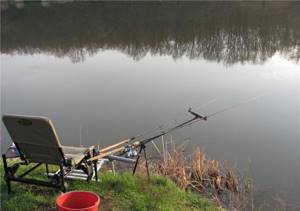
Feeder and picker are gear that came to us from distant England. They are similar in many ways, but also have significant differences. The first type is intended for more serious fishing and is superior to the second in all characteristics, but this does not mean that fishing with its use will be more effective. The picker rod, as well as all other elements of the gear, have lower performance. Despite this, the picker has many advantages, with the help of which it has found its supporters and has earned considerable popularity among professional fishermen.
What is the difference between a picker and a feeder?
Many beginners are familiar with the feeder, but despite this, not every one of them knows what a picker is. Picker - this light bottom tackle, which belongs to the feeder class, is used for fishing in combination with light feeders or sinkers. Flexible tips allow you to see the bite of even the smallest and weakest fish.
In order to correctly arrange the elements of a picker and select a fishing rod, you need to understand what it is and how it differs from a feeder. The difference in design is that the picker has two main bends and a tip. Feeder rods, including ultralight ones, are three-piece (three legs and a tip).
The picker tackle also differs from the feeder in that the first option requires the constant use of a feeder, which serves to deliver bait to the fishing site, and also as a sinker. As for the picker, the feeder is used only for initial feeding. In the future, when the fish approaches the desired area, the use of a feeder becomes impractical. Its splash during casting creates an unpleasant noise that scares away potential prey.
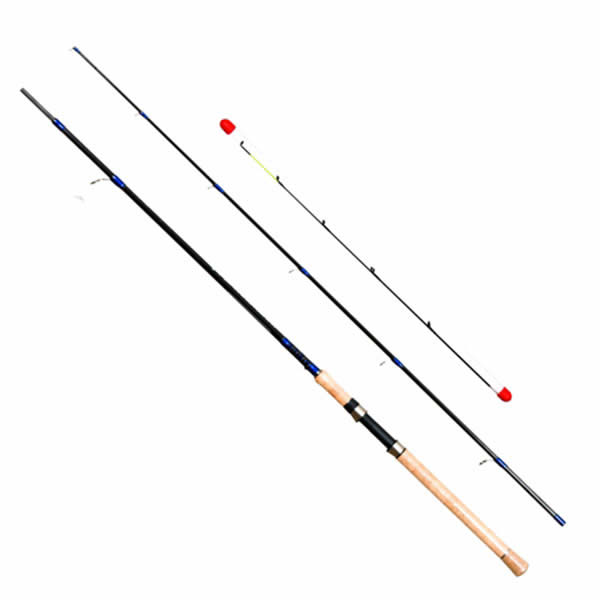
Photo 1. The same feeder, only shorter!
After several casts of the tackle with the feeder, the bite may stop. In this case, an ordinary lead sinker comes to the rescue, as it enters the water much more quietly. At this time, the fish will already accumulate in the fishing area, and food delivery will no longer be necessary. Thanks to this, fishing with pickerel is much more effective.
Note! Some fishermen also practice another method of feeding. Since fishing from the shore with pickerel is carried out at shallow depths, the sinker is hooked immediately, and the bait is thrown into the water by hand.
Advantages
Advantages of a picker compared to a feeder:
- Lighter and smaller equipment is much easier to handle. The fisherman can make quality casts in places where there are coastal trees. The use of a long feeder in such areas very often becomes impossible. At the same time, the power of the picker is much less and it will not be possible to compete with particularly large specimens.
- A lightweight lead sinker makes an almost imperceptible sound, which scares the fish much less than in the case of a heavy feeder. But this disadvantage of feeder gear is compensated by the fact that fishing with their use is carried out at great depths, where the fish may simply not hear this sound due to the great distance.
- You can feed them in two ways - using a feeder weight or manually.
- The cost of a picker is much less than a feeder.
Flaws
The main disadvantages of picker:
- Fishing in bad weather with strong winds is difficult, as the fishing line loses tension. In this case, bites will not be transmitted correctly to the rod. But if we compare the picker and float fishing methods, then the second one is much inferior, especially in the autumn. For example, if we consider the bite of crucian carp on a float and pickerel, autumn makes its own adjustments in the form of a wind-driven wave. In such conditions, tracking a bite on a float is very difficult, and sometimes even impossible.
- Equipment suitable for pickerel is not used for fishing at long distances from the shore. Not everyone can catch a big fish, but professionals can argue with this, since many people have been able to catch small carp on a pickerel.
Tackle layout
The length of the picker rods used varies from 2.1 m to 3 m, weight – about 100 grams, test – up to 50 grams.
Almost any reel for picker is suitable, but you need to correctly determine its size. For beginners, it is recommended not to take risks with the choice and take a reel with size 3000 from a good manufacturer. In the future, with the accumulation of experience, the fisherman will be able to easily select reels and install more effective gear.
As the main fishing line, it would be most suitable to use monofilament with a diameter of 0.14 mm to 0.2 mm. Its advantage is its stretchability, which has a positive effect on fishing when a powerful specimen is hooked.
The leashes are made from fishing line with a diameter of 0.12–0.14 mm. You definitely need to pay attention to the quality of the thread and purchase only those products that have good reviews. The length of the leashes is selected depending on the bite. If the fish is active, then a short leash is suitable; if not, a long leash is tied.
Picker feeders are selected depending on the fishing conditions. If you plan to hunt bottom fish, use those devices that can deliver food to the bottom of the reservoir. To catch species that spend most of their time in the upper or middle layers of the water column, you need to use feeders that release bait immediately after casting.
Application area
Picker is mainly used in reservoirs with standing water. If there is a current, it should be small or, at least, medium. Casts are made over short or medium distances. Very rarely the fishing range reaches 30 meters. Fishing for crucian carp with pickerel, as well as roach, rudd, bleak, silver bream, and small bream is carried out most often. With the right equipment and extensive experience, you can catch a fairly large specimen.
Picker fishing. Feeding the catch point
Feeding or, as they also say, feeding the catching point is of great importance in pickerel fishing.
As a rule, for fishing near the shore, bait is simply thrown by hand in the form of balls. To throw bait over a long distance, they use special slingshots, not much different from the combat slingshots from the arsenal of snotty and dirty boys of the twentieth century... Despite the difference in the methods of delivering bait, the goal is always the same - to always get to the same place in order to create in this place such the so-called feeding background, where the fish should approach and where it will stay during the entire fishing. But in order to then accurately throw the equipment into the baited place, you need to note the casting length and landmarks on the opposite bank. If a bush on the other side of the pond or a fisherman sleeping under a bush is suitable as one of the coordinates, then the casting length can be fixed by pinching the line in the clip on the reel. If the clip does not have a Teflon gasket, then the line where it is pinched in the clip may deform over time and lose strength. In order not to pinch the fishing line directly in the clip, you can grab it on the reel with a thin elastic band, the ends of which can be inserted into the clip. By the way, this way of fixing the length of the fishing line is safer if a large fish takes it. A fishing line pinched in a clip may not hold up when fishing for a large fish. The rubber band will simply break or slip out of the clip. Another way to indicate the length of the fishing line is to mark it. In the right place you just need to mark it with a white marker. This will be the casting distance threshold.
Now about the other details of the picker equipment...
The average length of leashes is 20-50 cm. Such a wide range in indicators is due to the fact that sometimes the length of leashes has to be changed right on the shore, depending on the biting activity. Often, during a sluggish bite, all you have to do is make the leashes longer, and the bite picks up. This is especially true for catching bream and large roach, which like to take slowly sinking bait. But when an active fish begins to swallow the hook up to a certain section of the rectum, it is better to shorten the leashes...
To avoid tangling, leashes are often twisted, making them double and more rigid. Everything is simple here. The fishing line is folded in half and a knot is tied at one end. Then, at the bend in the fishing line, a rod or nail is inserted, the rotation of which creates something similar to the braid of Vasilisa the Wise... The leash becomes more elastic and less tangled.
The choice of hooks depends on the attachment
Hooks with a short shank and a special curve, called carp, are suitable for fishing with maggots and plant baits. If the bait is worms and various “sandwiches” of worms with maggots, as well as with the addition of foam balls, then hooks with a long shank will be required. Feeder hooks made in Japan are unrivaled as they are the thinnest, sharpest and most durable. The size of hooks for pickerel fishing is usually selected according to the condition of the potential prey. The smallest hooks are used for catching crucian carp. Although there are reservoirs where crucian carp look like strong and broad-bodied village peasants, and weigh more than a kilogram. For such fish and hooks you need appropriate ones. “Swallowers” will not work here. But usually hooks No. 6-18 are used for pickerel fishing.
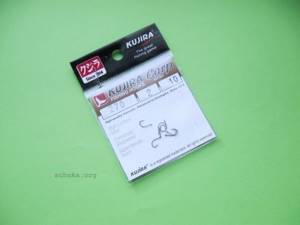
Picker equipment
With a top picker test of 50 grams, you can use light feeder feeders weighing 10-20 grams. There is an opinion that with a sinker weighing up to 20 grams, both asymmetrical and symmetrical rigs reduce the sensitivity of the rig.
Most likely this happens because they are knitted from thick fishing line to make a twist, and a light sinker sometimes makes it difficult to tension them, which reduces the sensitivity of the equipment. We also do not recommend using an anti-twist tube on a picker, as it greatly affects the range and accuracy of casting light weights. It is advisable to consider light picker rigs - the same “blind” and “sliding” rigs.
An important part of the picker is the various equipment that each angler chooses to suit his taste.
Anti-twist devices have begun to be used noticeably less often, although they work quite well in strong currents. The most popular rigs are those named after the way they are knitted and the location of the leash. These are symmetrical and asymmetrical loops. In the same row is the so-called paternoster from Steve Gardner, also known as the “Gardner rig.” The listed equipment is quite simple and sensitive to the most careful bite. But light spiral feeders, working as a sliding sinker, are in some cases most successful for fishing in weak currents. They do not sink into the muddy bed and quickly respond to a bite. Just like in the feeder, cage feeders are also used for picker fishing, but usually the lightest of them, corresponding to the action of the rod. Of course, at long distances they will be inferior to modern feeders such as Method and in particular Flat, which are more often used in feeder fishing, but an angler with a picker does not need ultra-long throws.

Equipment for picker - Gardner paternoster and Inline
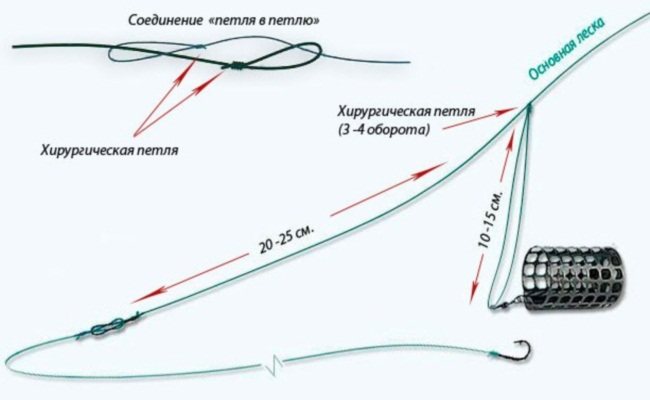
The main feature of the Gardner paternoster is its simplicity and reliability.
Offering to watch the installation of equipment is always better than forcing you to read. Therefore, I suggest that you watch the video with all the stages of manufacturing the Gardner paternoster and the In-Line feeder equipment.
The only moment. When describing the Carrot knot, the cone of the knot needs to be knitted in the opposite direction.
And in conclusion, an interesting video from a professional pickerel fisherman describing the main points of fishing.
NHNCH. Sergey K. Krasnoyarsk
Opinions between amateurs and professionals often differ. This is what feeder fishing pro Normunds Grabovskis said on the pages of salmoru:
Pickerel fishing. Lure
Lately, there is no need for anglers to rack their brains over the composition of bait. Now there are many ready-made and effective feeder mixtures for a wide variety of fish and for any season. But there is still room for creativity, because the saturated modern fish sometimes begins to get weird, showing interest in fruit yoghurts, garlic and kerosene. You can opt for domestic mixtures. They attract fish and are relatively inexpensive. But the angler always finds his own bait, for a specific fish and a certain time of year.
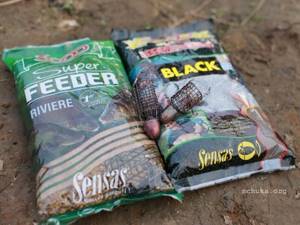
Bait
The worm has been and remains the classic and most common bait for almost any fishing. Picker is no exception.
Small dung worms, white and colored maggots, caster, bloodworms, “sandwiches” in various combinations, semolina, rye bread, pearl barley, polystyrene foam - this is the main set of baits and attachments for pickerel fishing. With the onset of autumn cold, many fish leave their summer camps and move closer to the dumps to the pits, where the water is now warmer than in coastal shallow waters. In addition, these pit dumps, their upper and middle edges, sort of floors along the perimeter of the pit, can be called residential areas where algae live and reproduce, and various underwater insects live in them. And this is food for many fish. In addition to insects, on such improvised terraces not only plants edible for fish grow, but also entire colonies of river mollusks - zebra mussels, toothless mussels and barley mussels - breed. This is already food for large fish - bream, ide and chub.
However, any large fish will not refuse a tender mollusk if it is possible to get to it. But if large mollusks are not always available for fish, but only open during illness and death, then zebra mussels bream, ide, and large roach “crunch” like sunflower seeds. Therefore, in the autumn, zebra mussel, which is called a shell, can also be bait for pickerel when fishing at depth. And the picker, together with the feeder, in the fall is the most popular tackle for catching “white” fish.
Picker fishing from a boat
Fishing with pickerel from a boat is one of the most exciting activities. You can use it if you can’t cast your fishing rod to more fortunate places where the fish are found.

Of course, you can use a feeder in this matter, but experienced fishermen prefer a picker. In this case, its disadvantages become invisible, and its advantages only delight anglers.
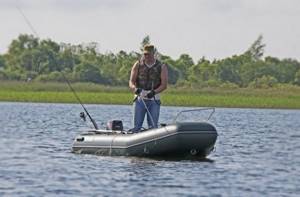
A huge advantage of the picker is its light weight. Agree, it is not very convenient to install a huge fishing device in a compact boat. You can attach a feeder of any size to the boat.
